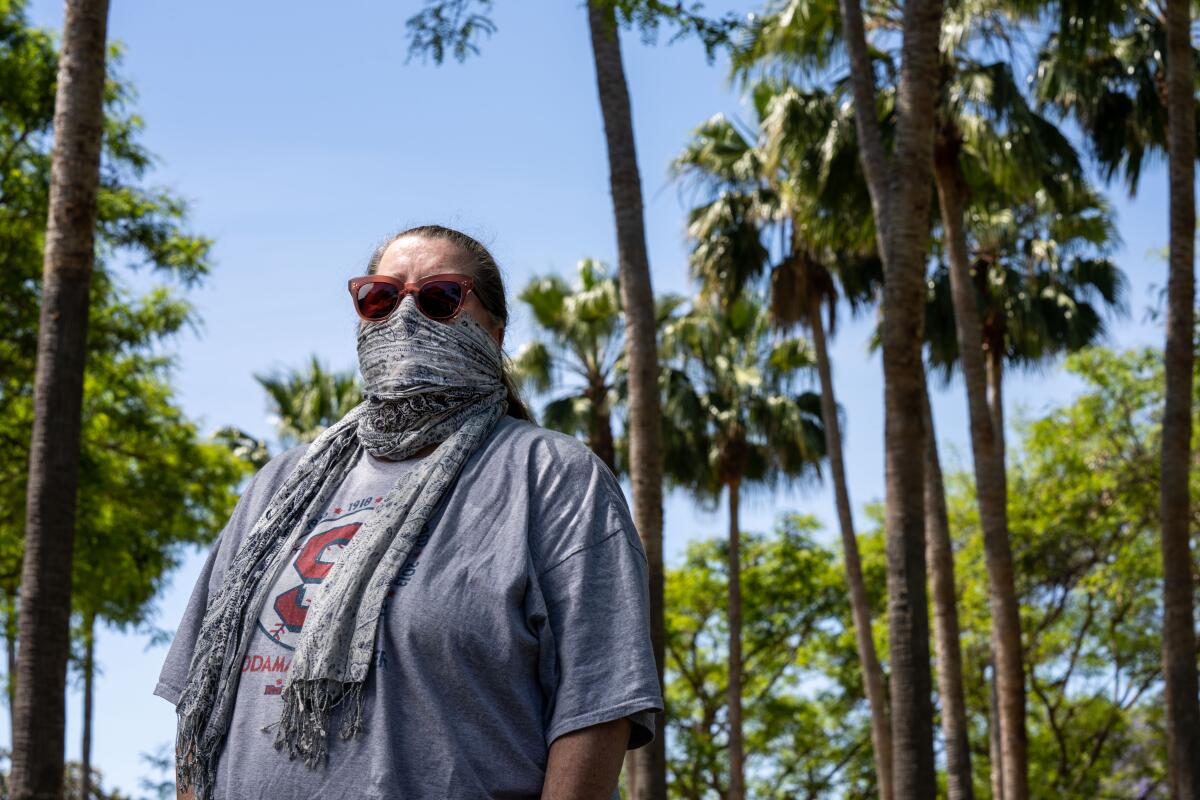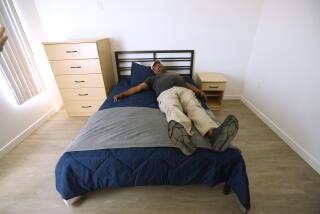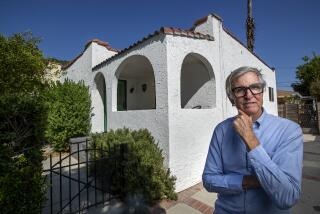How coronavirus has upended life for thousands at California’s largest apartment complex

In the middle of March, Luc Bernard came down with something he had never felt before. He had a constant cough, trouble breathing and couldn’t get to sleep. Fearing he had the novel coronavirus, he went to the hospital.
Back then, it was hard to get tested. Instead, doctors told him to go home and self-isolate. But that’s not easy when you live in Park La Brea, surrounded by more than 10,000 people, all connected via elevators, hallways, tree-lined paths and parking lots.
Bernard told his landlord, Prime Residential Apartments, that he planned to sequester himself in the two-story, three-bedroom apartment he shares with a roommate. So he was surprised to come downstairs one morning to find a maintenance worker fixing a broken light in his kitchen.
“He had a mask and everything on, but I was still like, ‘What the hell?’” said Bernard, a 33-year-old video game developer.
Nowhere in Los Angeles are the logistical, financial and health complications of the coronavirus outbreak on greater display than at Park La Brea — the largest housing complex west of the Mississippi River. The post-World War II landmark on the Miracle Mile is home to a small town’s worth of people living in 4,245 high-rise and garden-style apartments on 160 acres.
Older tenants worry about crowding into elevators with maskless neighbors. Younger tenants worry about how they’re going to pay rent. And everyone seems to have a story about an awkward interaction in one of Park La Brea’s communal laundry rooms or along one of its manicured streets or sidewalks.
Homemade signs, residents say, have warned of the coronavirus spreading within Park La Brea — though there’s no evidence that’s happening — and management’s response to the pandemic has frustrated some tenants.
Nevertheless, many say they love living at Park La Brea despite the immense challenges of being so close together when people are supposed to be as far apart as possible. Sharing the pandemic experience has amplified a sense of community that residents say is helping them cope.
“You can see that people are out and about, sitting on their back porches, calling out to each other,” said Sabrina Knight, 26, who co-owns a digital marketing business and has lived at the complex for nearly four years. “Everyone’s in the same boat.”

On a recent Friday afternoon, roommates Asante Parker and Autumn Slyve were taking a break after a run outside.
The 22-year-olds moved into Park La Brea last fall after graduating from UCLA and are embarking on careers in the entertainment industry. They liked living there so much that Parker’s mother agreed to move into another apartment down one of the manicured streets.
After the state and local stay-at-home orders went into effect, Parker and Slyve lost their restaurant jobs. They’re struggling to make ends meet. Slyve skipped her rent in April but recently got some money from her mom and a check from an acting job — enough to take care of food and housing costs for now. Parker is earning cash by teaching dance lessons on Zoom.
The women mostly worry about big things, including their health. But they also worry about small, regular social interactions within Park La Brea.
“We just saw a cute dog and we didn’t know if we could pet it,” Parker lamented.
Susan Ferris, president of the Park La Brea Residents Assn., said she expected to hear from tenants who were upset. But she was surprised to hear gripes about the closure of the complex’s gym, café and movie theater. She has fielded complaints about people walking their dogs without leashes.
Sometimes tenants just want someone to listen to them, she said.
“A lot of it is keeping people calm,” said Ferris, 56, who owns a talent management company. “They really have turned to us to let them know we’re all in it together and we’re all going to get through it together.”

Park La Brea was designed to feel like a stand-alone community. Planning began in the late 1930s, with long blocks of two-story apartments envisioned along diagonal streets to set them apart from the gridded streetscape seen throughout Los Angeles.
A housing shortage after World War II led developers to add 13-story towers to the design. When the complex was complete in 1952, 18 of them were connected by roads lined with garden apartment buildings, tree-filled medians and expansive open spaces.
Over the decades, Park La Brea has cycled through eras of chic — actor Charlton Heston lived there in the 1950s — shabby chic and just plain shabby.
But the complex has remained popular over the years because of its competitive rental rates, reputation as a haven for those trying to make it in Hollywood and great location, sandwiched between the Los Angeles County Museum of Art and the Grove. Many Angelenos have lived at Park La Brea or know someone who has.
Recently, the economic devastation tied to the coronavirus has led many tenants to scramble to pay their rent.
In late March, the Los Angeles City Council approved new rules to prevent evictions by giving economically affected tenants a year to pay past-due rent.
Initially, tenants said Park La Brea’s management sent them a letter requiring them to turn over bank statements and other financial information if they wanted to avoid being thrown out for not paying rent. City regulations don’t mandate such disclosures outside of a courtroom.
Management later clarified that it was only requiring documentation to qualify for an internal Park La Brea program, under which tenants would get a 10% discount on rent in April and May if they agreed to repay it by the end of August.
But the residents’ association is telling tenants to be wary of that offer, fearing enrolling in the program could make it easier to file evictions later. Prime Residential Apartments says that’s not its plan.
Park La Brea also has slashed the rent on vacant apartments in recent months. That has encouraged existing tenants, many of whom are looking to save money in an economic downturn, to break their leases and move into other apartments within the complex.
David Patton, 63, lived in a two-bedroom, one-bathroom garden apartment with his wife and son. They paid $2,660 a month. But the family found a slightly larger apartment in Park La Brea — for $400 a month cheaper. A supervisor at an Amazon retail store, Patton said he would have preferred if Prime Residential Apartments had just lowered the rent for his previous apartment. But that wasn’t the deal.
“It was inconvenient,” Patton said, “but the inconvenience was outweighed by the economics.”

Moving, even within Park La Brea, means running afoul of public health orders to stay at home as much as possible and to avoid mingling with others to slow the spread of the coronavirus.
That worried Knight, who is immunocompromised. But the digital marketer felt she had little choice but to get her own apartment.
After three of her four roommates moved out in March, she finally decided it was time. Knight began by wearing an N95 mask and gloves while she and some friends used a dolly to wheel furniture down the street. But it got so hot out that she ultimately had to take off the gloves and switch to a cloth mask.
It’s hard to know how many Park La Brea residents have contracted the virus. As of Saturday 19 people had tested positive in Park La Brea and the surrounding neighborhood, according to the L.A. County Department of Public Health.
Parker and Slyve said someone posted a handwritten note in an elevator saying that multiple people were infected in the complex.
Prime Residential Apartments said it learned of one tenant who had it and notified residents in mid-April. However, it didn’t remove notices posted in the lobbies of some apartment buildings that said management was unaware of any tenants who had been infected. Management changed the signage after being notified by The Times.
Even though Park La Brea’s size makes it exceptional, the responsibilities for tenants and landlords during the pandemic are largely the same as they would be in a smaller development, said Shira Shafir, an associate professor at UCLA’s Fielding School of Public Health.
Residents should get tested if they have symptoms, isolate themselves in their apartments if they test positive and notify county public health officials of others with whom they’ve recently been in contact, she said. And landlords should provide accurate information to tenants, clean common areas and respond to the public health department.
“It’s not as if just living in the same apartment building changes someone’s risk,” said Shafir, who lived in Park La Brea when she was a graduate student at UCLA. “It’s really about the contacts that an individual has had.”
Before moving day, Knight said she hadn’t left her apartment in weeks except to get a check from her bank for the security deposit. In her new place, Knight won’t turn on her central air conditioning because she’s afraid of what’s in the vents.
Her parents, who live in central Massachusetts, offered to let her move home and ride out the pandemic there. But Knight thought of the sounds of children playing outside her apartment, how close she’s gotten with her neighbors and the small joys such as listening to people drive around the community honking their horns to celebrate friends’ birthdays.
She’s staying.
“I can’t really see myself anywhere else,” Knight said.







